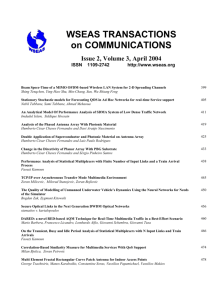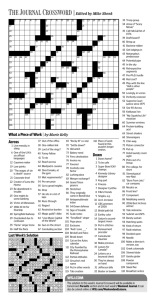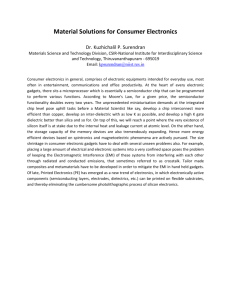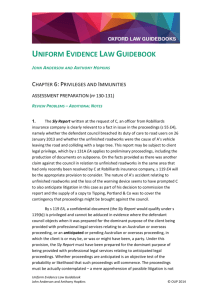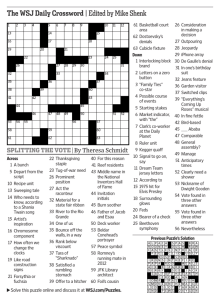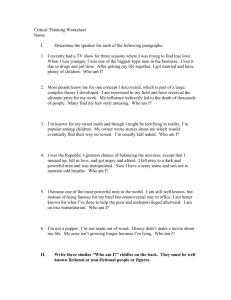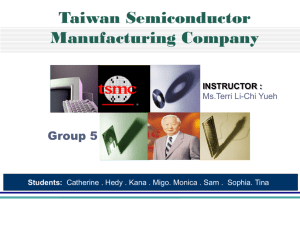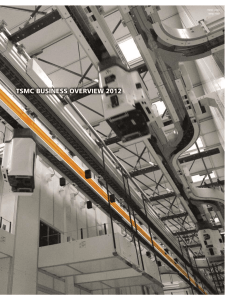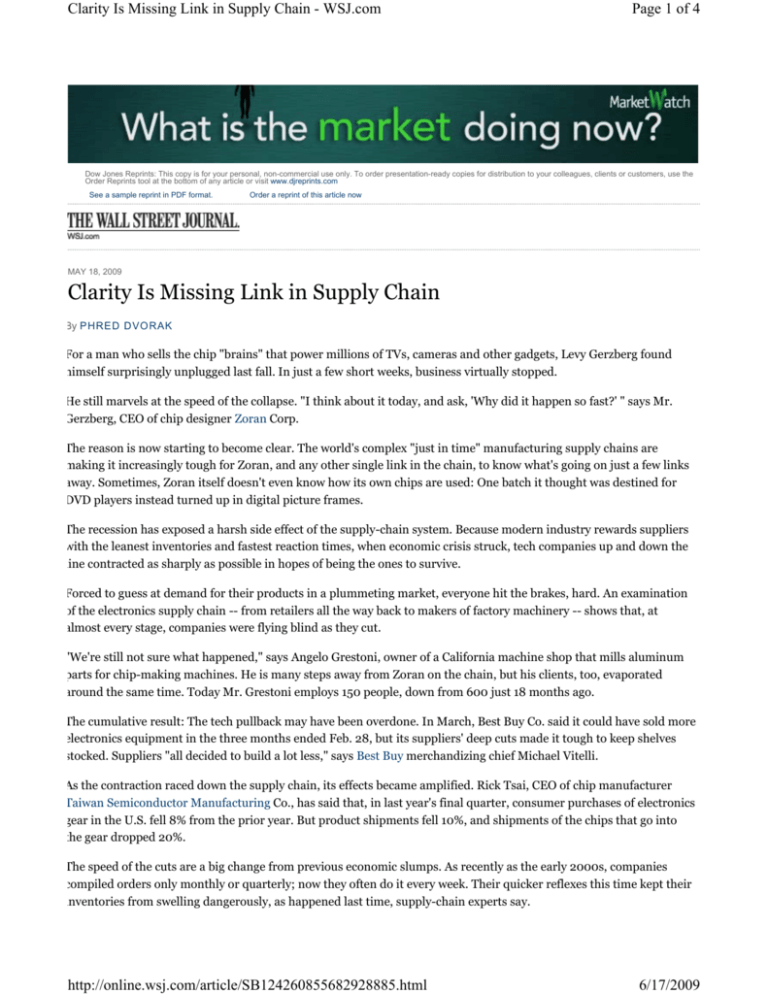
Clarity Is Missing Link in Supply Chain - WSJ.com
Page 1 of 4
Dow Jones Reprints: This copy is for your personal, non-commercial use only. To order presentation-ready copies for distribution to your colleagues, clients or customers, use the
Order Reprints tool at the bottom of any article or visit www.djreprints.com
See a sample reprint in PDF format.
Order a reprint of this article now
MAY 18, 2009
Clarity Is Missing Link in Supply Chain
By PHRED DVORAK
For a man who sells the chip "brains" that power millions of TVs, cameras and other gadgets, Levy Gerzberg found
himself surprisingly unplugged last fall. In just a few short weeks, business virtually stopped.
He still marvels at the speed of the collapse. "I think about it today, and ask, 'Why did it happen so fast?' " says Mr.
Gerzberg, CEO of chip designer Zoran Corp.
The reason is now starting to become clear. The world's complex "just in time" manufacturing supply chains are
making it increasingly tough for Zoran, and any other single link in the chain, to know what's going on just a few links
away. Sometimes, Zoran itself doesn't even know how its own chips are used: One batch it thought was destined for
DVD players instead turned up in digital picture frames.
The recession has exposed a harsh side effect of the supply-chain system. Because modern industry rewards suppliers
with the leanest inventories and fastest reaction times, when economic crisis struck, tech companies up and down the
line contracted as sharply as possible in hopes of being the ones to survive.
Forced to guess at demand for their products in a plummeting market, everyone hit the brakes, hard. An examination
of the electronics supply chain -- from retailers all the way back to makers of factory machinery -- shows that, at
almost every stage, companies were flying blind as they cut.
"We're still not sure what happened," says Angelo Grestoni, owner of a California machine shop that mills aluminum
parts for chip-making machines. He is many steps away from Zoran on the chain, but his clients, too, evaporated
around the same time. Today Mr. Grestoni employs 150 people, down from 600 just 18 months ago.
The cumulative result: The tech pullback may have been overdone. In March, Best Buy Co. said it could have sold more
electronics equipment in the three months ended Feb. 28, but its suppliers' deep cuts made it tough to keep shelves
stocked. Suppliers "all decided to build a lot less," says Best Buy merchandizing chief Michael Vitelli.
As the contraction raced down the supply chain, its effects became amplified. Rick Tsai, CEO of chip manufacturer
Taiwan Semiconductor Manufacturing Co., has said that, in last year's final quarter, consumer purchases of electronics
gear in the U.S. fell 8% from the prior year. But product shipments fell 10%, and shipments of the chips that go into
the gear dropped 20%.
The speed of the cuts are a big change from previous economic slumps. As recently as the early 2000s, companies
compiled orders only monthly or quarterly; now they often do it every week. Their quicker reflexes this time kept their
inventories from swelling dangerously, as happened last time, supply-chain experts say.
http://online.wsj.com/article/SB124260855682928885.html
6/17/2009
Clarity Is Missing Link in Supply Chain - WSJ.com
Page 2 of 4
This has consequences for economic recovery. Although U.S. gross domestic product fell 6.1%, on an annual basis, in
the first quarter, nearly half of that was due to inventory reductions. Since consumer spending actually grew 2.2%,
some factories might need to increase output, economists say.
Production is starting to snap back, at least a little. Taiwan Semiconductor, or TSMC, in March boosted first-quarter
earnings, and Zoran last month reported a jump in forecast orders.
Still, "It's easier to turn the switch off than turn it back on," says David Pederson, Zoran's vice president of corporate
marketing. Growth forecasts also get muddied because several of Zoran's customers may be optimistically competing
for the same manufacturing contract, he says, and they can't all win it.
Zoran is the kind of niche firm spawned by the widely dispersed global tech industry: It designs specialized video- and
audio-processing chips for products such as cameras, TVs and cellphones. Its customers are mainly little-known Asian
companies -- rent-a-factories, basically -- that manufacture the world's gizmos on behalf of brand-name giants like
Toshiba Corp.
Complexities in the global supply chain make it tough to divine broad market trends, says Randy Bane, an economist
for Applied Materials Inc., which makes factory equipment used to build chips like Zoran's. Applied Materials had a
loss of $133 million in its fiscal first quarter and a loss of $255 million in the second quarter, ended April 26 -- its first
quarterly losses since 2003. It told employees to take four weeks of unpaid leave in the first half of this year, something
it's never done before.
Just a decade ago, the supply chain had far fewer links, Mr. Bane says. Chip sales were driven largely by personal
computers, and just a handful of companies were bellwethers for the industry. Today, everything has a chip in it,
dramatically multiplying the complexity. Behavior is "much more difficult to predict," he says.
At one end of the information flow are retailers such as Best Buy. For the U.S. market, it sends orders to its suppliers
once a week, along with private forecasts for the coming 52 weeks, based on sales at its 1,000 U.S. stores and broader
economic data. Manufacturers scrutinize reports like these to decide what parts they need to order.
The system is geared to respond quickly to changes in consumer behavior. But that puts risk on suppliers' shoulders.
Take DVD players: Best Buy orders them about six weeks before it wants them on shelves. However, a player's guts
may take twice that long to make -- forcing gadget makers and their suppliers further down the chain to guess at
demand for the various pieces.
Companies all along the supply chain live in mortal fear of piling up inventory. Profit margins are razor thin, and
unsold inventory only loses value as newer technologies hit the market.
Last fall, as the financial crisis struck Wall Street in full force, shoppers at Best Buy became an endangered species. By
early October -- the deadline to place orders for the all-important Thanksgiving shopping season -- Mr. Vitelli, the
merchandising chief, abandoned Best Buy's prior forecasts and slashed orders to electronics giants such as Japan's
Toshiba and South Korea's Samsung Electronics Co.
Demand was shrinking so rapidly, he says, he wasn't even sure how deeply to cut. "You actually had to pick a number
with no knowledge whatsoever, because nobody knows anything," he recalls. For the three months ended Nov. 29, Best
Buy's net income fell 77%.
If Best Buy felt ambushed, its suppliers had even less insight into consumer demand. The slashing began.
Two or three links down the chain, chip designer Zoran quickly felt the pain. Even before last fall's crisis hit, Zoran's
customers were getting nervous, executives say. When Best Buy and other retailers cut their orders in October, it
http://online.wsj.com/article/SB124260855682928885.html
6/17/2009
Clarity Is Missing Link in Supply Chain - WSJ.com
Page 3 of 4
turned into a rout.
"Everyone was looking at others, asking, 'How much money do they have? Can they survive?' " recalls Mr. Gerzberg,
Zoran's CEO.
Manufacturers cut deeply, then cut some more. Shipments of audio-visual products such as TVs and MP3 players fell
19% in November, 21% in December and 58% in January, the Consumer Electronics Association says. Zoran's fourthquarter revenue fell 42%, the steepest drop since the company went public in 1995.
"There was a lot of guessing going on," says Mr. Pederson of Zoran. "Everybody under-bet to a certain extent."
The effects ricocheted across Asia. In Japan, the economy shrank at an annualized pace of 12.7% in the final three
months of last year, the fastest drop in nearly 35 years.
In China, many of Zoran's factory customers furloughed their workers, says Mr. Gerzberg. In recent months, some 20
million Chinese migrant workers have lost their jobs.
Zoran doesn't actually make the chips it designs. Instead, it subcontracts with TSMC. Zoran slashed its chip orders -as did many of TSMC's hundreds of other customers.
TSMC's chip factories fell quiet, says Rick Cassidy, head of North American operations. In December, its plants ran at
an estimated 35% of capacity, the lowest in at least eight years, according to market researcher iSuppli Corp.
In subsequent months, TSMC asked around 20,000 of its workers to take as many as five days of unpaid leave a
month. In January and February, TSMC said revenue fell 58% from a year earlier. And it said it will slash its 2009
purchases of factory equipment by some 20% from a year earlier. Across Taiwan, plunging demand for electronics led
to record declines in Taiwanese industrial output.
"Usually the guy at the rearmost end suffers the most," says Morris Chang, TSMC's chairman.
In Santa Clara, Calif., those cuts came as a rude shock at the offices of Applied Materials, which builds factory
equipment used to etch circuits and bake chemicals onto semiconductors.
As recently as last summer, Applied's in-house economist, Mr. Bane, had expected second-half business to grow.
Instead, it laid off 2,000 workers and asked all remaining 12,000 employees to take unpaid leaves.
Mr. Bane gives presentations on what's happening in the market to some of Applied's immediate suppliers -- including
Mr. Grestoni, the owner of the California machine-tool shop who's had to lay off hundreds of his employees.
In fact, Applied is one of Mr. Grestoni's biggest customers. One of Mr. Grestoni's shops, D&H Manufacturing Co., won
Applied Materials' supplier-excellence award for 2007 and 2008.
The downturn is brutalizing Mr. Grestoni's business. He's now sitting on a year's supply of some products, rather than
the typical three months. "We've got millions of dollars of inventory we can't sell, and we're paying storage fees on it,"
he says.
One recent morning, Mr. Grestoni walked by empty rows and stilled machines at D&H. In one section stands six
powerful milling machines in which sharp, whirling blades carve blocks of metal. Fifty people used to work there.
Today, only one remains.
He paused by a pile of aluminum blocks, each roughly the size of a microwave oven. One has large round holes milled
out of the center, for wafer-processing chambers. "In October, we get an order to do six of these," he says. Then, the
http://online.wsj.com/article/SB124260855682928885.html
6/17/2009
Clarity Is Missing Link in Supply Chain - WSJ.com
Page 4 of 4
customer delayed the order. "You're looking at 60 grand here."
Mr. Grestoni expects sales for his three machine shops this year to total less than $50 million, compared with $100
million in a typical year.
There are a few hopeful signs. Best Buy has seen improved sales. Zoran on April 28 said it expects business to pick up
in coming months, even though first-quarter sales fell 37%. And TSMC ended its factory furloughs in April.
But Mr. Grestoni is still waiting. "We've probably hit the bottom," he says. "Now the question is, how long are we going
to stay here."
—Ian Johnson and Ting-I Tsai contributed to this article.
Write to Phred Dvorak at phred.dvorak@wsj.com
Printed in The Wall Street Journal, page A1
Copyright 2009 Dow Jones & Company, Inc. All Rights Reserved
This copy is for your personal, non-commercial use only. Distribution and use of this material are governed by our Subscriber Agreement and by copyright
law. For non-personal use or to order multiple copies, please contact Dow Jones Reprints at 1-800-843-0008 or visit
www.djreprints.com
http://online.wsj.com/article/SB124260855682928885.html
6/17/2009

